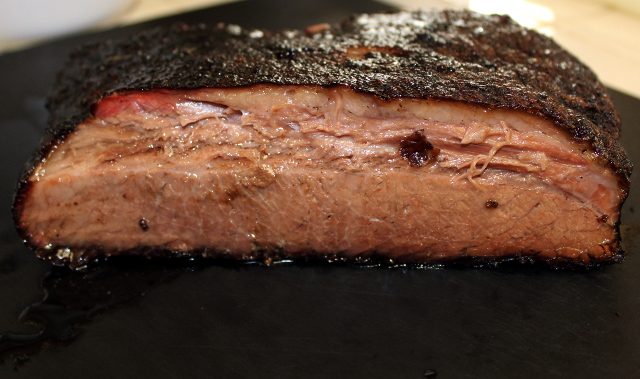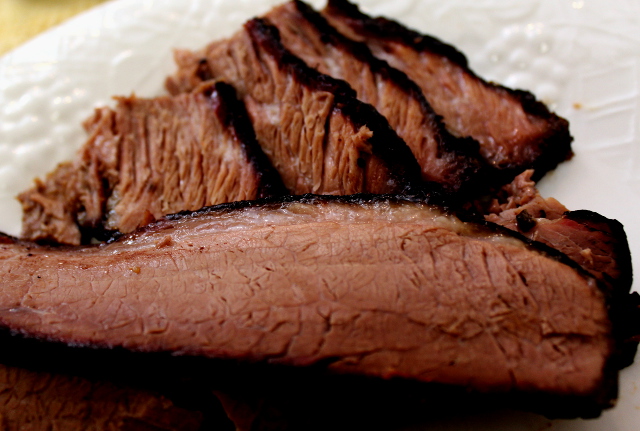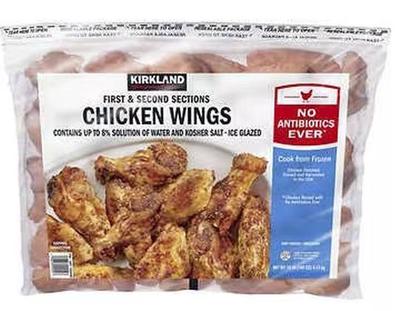How to Barbecue a Brisket
Print This Recipe
Hello!
Welcome to How to Barbecue a Brisket 101.
In this course, I will give you an overview of brisket. Then we will discuss:
- How to choose a brisket for barbecue.
- How to prepare your brisket for barbecue.
- How to barbecue a brisket.
Overview
Beef brisket is a funny piece of meat.
It's the pectoral muscle of the cow, or more appropriately, the steer.
(The best cuts come from the male of the bovine species; the steer. We'll use the term cow because that's the term that most people associate with beef.)
The brisket is the chest muscle. It runs across the animal's chest and up under the neck.
Since the cow stands on four legs, this muscle gets quite a workout, holding the animal up and helping it get around. It's actually the second toughest cut of meat on a cow. The toughest cut is the shank.
(The muscles on the top of an animal are more tender than the ones lower down. That's what "eating high on the hog" means: when you eat high on the hog or steer, you're eating the more tender cuts. The muscles at the bottom of an animal do more heavy lifting and are thereby tougher).
A full brisket, often called a packer brisket or whole packer brisket, is actually two muscles; the flat and the point.
The flat is the thinner, leaner portion of the brisket. The point is the thicker, fattier portion at the other end of the brisket.
It's one of the toughest beef cuts; the grain of the meat runs in different directions, and one muscle is thin and lean. The other muscle is thick and fatty.
These factors make cooking this cut a bit of a challenge.
But have no fear. Just pay attention to your brisket, take your time, and soon, you'll know how to barbecue a brisket that melts in your mouth.
How to Choose a Brisket for Barbecue
Choosing a nice brisket for your barbecue is an essential part of knowing how to barbecue a brisket.
When selecting a beef brisket to barbecue, there are some factors to consider;
- How Big is The Brisket? - Generally, bigger is better. A larger brisket has less chance of drying out. It also takes longer to barbecue bigger beef briskets, so you get better bark formation.
- Even Thickness - When choosing a brisket, pick one that has a thick flat. A brisket will never have the same thickness from flat to point, but if the flat is skinny, it will be overcooked by the time the point has finished cooking.
- The Grade of Meat - Briskets are not tender cuts of meat. They take a long time to cook. You need some fat in there to help keep the brisket moist. Higher grade meats have more fat in them.
- Marbling. After you've found the highest-grade beef brisket you can get your hands on, make sure you pick one that has the most marbling. It may be hard to tell because of the fat cap. Turn the brisket over and look at the flat to determine how much marbling the meat has. Also, look at the sides by the point; you should see any marbling there.
- Age. Speaking of turning the brisket over. Full packer briskets come in Cryovac packaging. This is what you want. You get several benefits from buying it this way;
- You can see the marbling through the package.
- You can feel the cut. A brisket with more soft fat and marbling will give more and be more flexible and floppier.
- Cryovac meats can keep longer. If you can, buy the brisket ahead of time. Age it for 2-3 weeks after the pack date, or up to the expiration date, in your fridge. This helps to tenderize the meat.
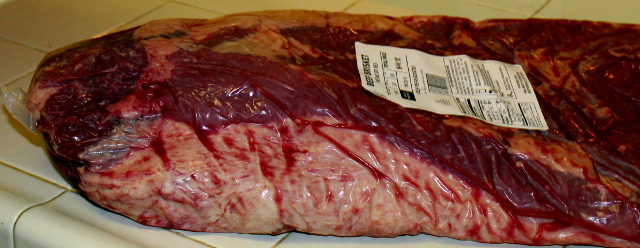 Beef Brisket in Cryovac
Beef Brisket in CryovacNext part of learning how to barbecue a brisket...
How to Prepare Your Brisket for Barbecue
Trimming Your Brisket
There are several lines of thought on trimming a beef brisket:
- Some people pull the brisket out of the Cryovac, apply a rub and throw it on the smoker.
- Others trim all the fat, along with large chunks of meat, before rubbing and cooking. Usually, this is done for barbecue competitions.
- Still, others leave a small layer of fat, about 1/8"-1/4" thick.
There are advantages and disadvantages to each method. Trimming your brisket always helps you turn out a better product. Before you barbecue beef brisket, you should do some trimming. Here's why...
- There are huge chunks of hard fat that will not render. A little fat on a steak that's grilled is tasty; this fat is not. Nobody wants a huge glob of fat in their meat.
- Removing the fat on the brisket's sides will reduce the thickness between the point and the flat. This will help the brisket cook evenly.
- A thick fat cap will not render or develop a good bark. It also blocks the rub from flavoring the meat.
Your Main Objective
When trimming a beef brisket for your barbecue, your main objectives are:
- Leave a 1/4" layer of fat.
- Remove the large chunks of fat at the point.
- Remove the silver skin.
- Square up the brisket to make it aerodynamic and promote even cooking.
The Art of Butchery
You don't have to be an expert butcher to know how to barbecue a brisket. But you will have to have some knowledge about it. In fact, a lot of good cooking will involve some skills with a knife and meat.
Butchery is definitely based on the science of anatomy. Still, there is a bit of art involved in learning the skill. No two briskets or any other cut of meat are the same.
It's going to take some experience and "feel" before you become proficient at trimming meat. I will explain it to you, but you have to pay attention to the cut and follow the meat's natural lines and contours.
Meat feels different than fat when you're cutting it. Bone feels nothing like meat or fat. (Fortunately, there are no bones in a brisket.) This is where the feeling part comes in. You will use your hands to feel where the fat ends and the meat begins.
Don't worry; with a little practice, you'll have it down. Even if you mess up and trim too much or not enough, it's okay. You'll still have a delicious barbecue beef brisket, and you'll learn how to do it better next time.
Tools of The Trade
You will need a few things to trim your brisket. First, you need a very sharp, thin knife. I use a stiff boning knife, pictured below. It's very cool and works great!
 My Wüsthof Boning Knife
My Wüsthof Boning KnifeFor more on boning knives and other barbecue tools you need, check out my barbecue tools page.
You also need an extra-large cutting board.
Tip: Place a damp kitchen towel under your cutting board to keep it from moving around. This makes cutting more comfortable and is safer than having your cutting board moving all over the counter.
If you don't have an extra-large cutting board, you can use your kitchen countertop; just make sure it's clean. Make sure you clean and sanitize your board and/or counter afterward.
You're also going to need a relaxed attitude and some patience. This is an essential part of knowing how to barbecue a brisket. Trimming a brisket is not hard; you just need to take your time and learn as you go.
Remember: Safety is of the utmost importance. Stay calm and take your time. If you get flustered and agitated, you may end up cutting yourself!
How to Trim a Beef Brisket
Note: These are the steps that I take. You can do them in any order that you like.
Remember: Your goal is to leave a 1/4"-1/8" layer of fat on your brisket. However, you get that done is up to you. After you've trimmed a few briskets, you may feel more comfortable doing it in a different way than I do. That's fine. Do it the way that makes you the most comfortable and helps you achieve the result you're looking for.
- Place the brisket on your cutting board with the bottom (the fat cap side) face up.
- Trim away the fat on the sides of the brisket. Taking a look at the brisket's sides when you trim the fat will give you some idea of how thick the fat cap is.
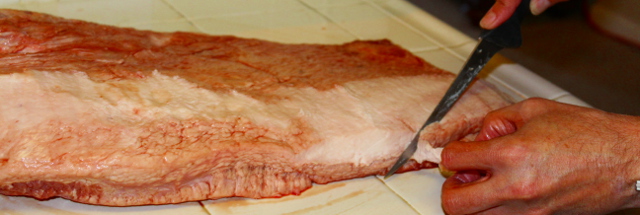 Trimming the Side of a Beef Brisket
Trimming the Side of a Beef Brisket3. Trim the fat cap to about 1/4" thickness. This is pretty straight forward; use your hands to feel the fat cap. This helps you tell you how much fat there is. Trim with your knife to about 1/4" thickness.
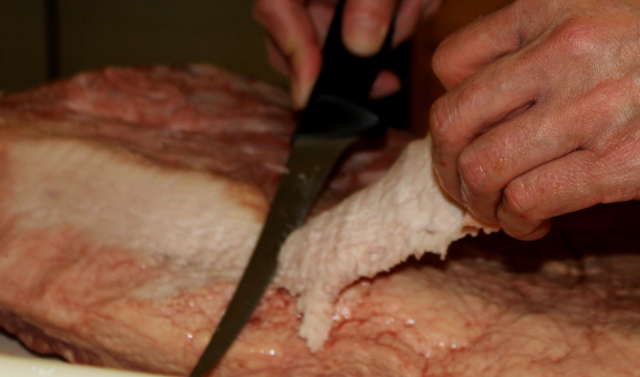 Trimming the Fat Cap on a Beef Brisket
Trimming the Fat Cap on a Beef Brisket4. Remove the large chunks of fat on the beef brisket's sides where the point and the flat meet.
There are large chunks of fat on the sides of the brisket near the point. Sometimes there is a large chunk of fat at the end of the point as well. This hard fat does not taste good and will not render well; it needs to be removed.
You can see this large chunk of fat in the picture below. It's a couple of inches thick and runs into the brisket a few inches into a v shape. It may be just a few inches in, or it may run entirely under the point. Feel with your hand to gauge how big it is and how it runs into the brisket.
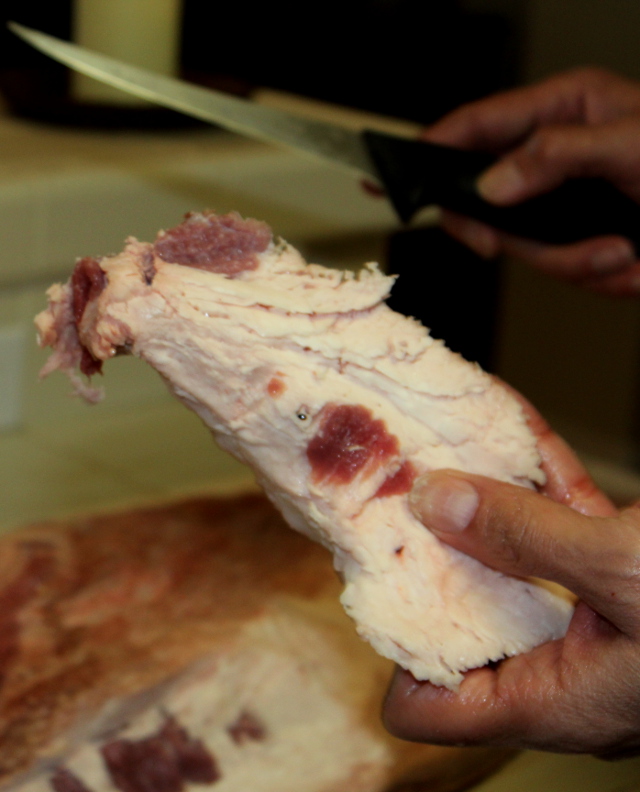 Chunk of Fat From a Beef Brisket
Chunk of Fat From a Beef BrisketUse your knife to remove this fat. Just start at the top and trim away. Then cut away from the bottom side to remove this fat. It's shaped like a v, so this is how you'll want to cut it out. See the photos below.
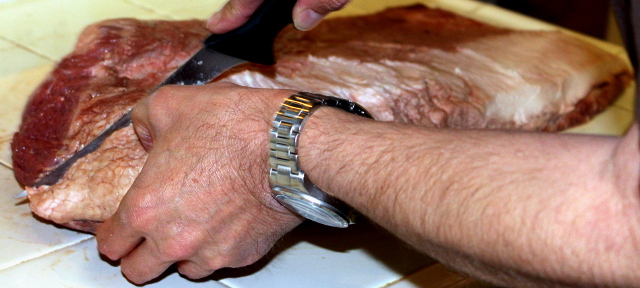
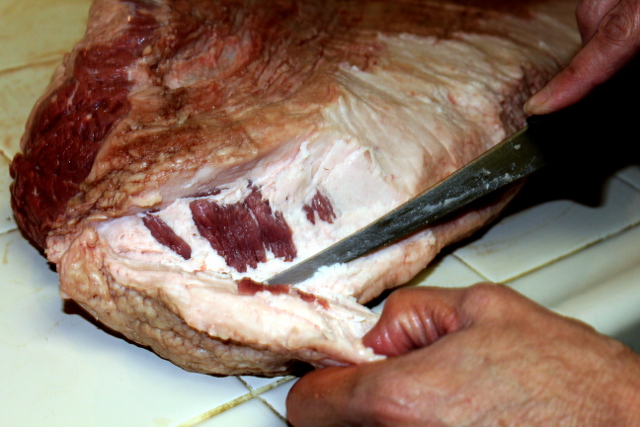
Do the same to the other side. If the fat runs under the point from one side to the other, remove it.
5. Remove the silver skin. Turn the brisket over, so the top (the meat side) is facing you. (See the picture below) The silver skin is the tough, silver-colored membrane on top of the meat. See those streaks of fat? The silver skin sometimes runs under those streaks of fat as well. If there is silver skin under the fat, remove it. If not, just trim that fat to 1/4". The brisket in the photo actually has very little silver skin.
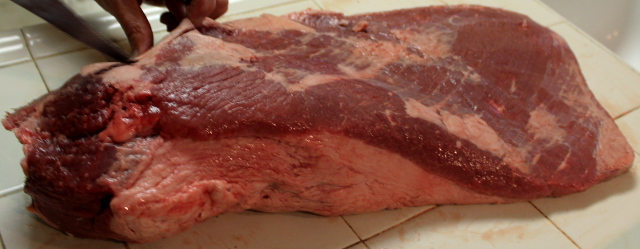
Remove the silver skin by putting your boning knife under it, angle your knife slightly upwards in your cutting direction. Hold the silver skin tight with your non-cutting hand and cut up against the silver skin to remove it while saving as much meat as possible.
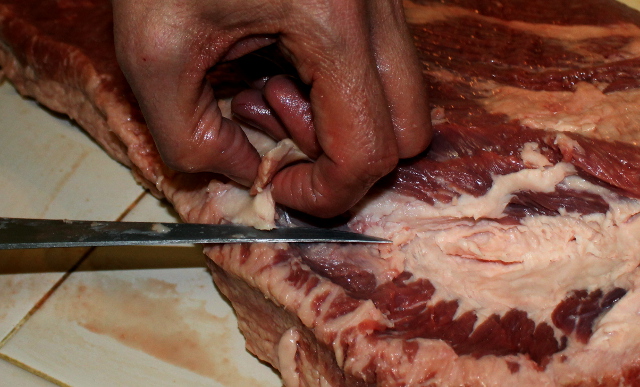
6. Trim the flat, even out the brisket. If the flat's end is less than an inch or so thick, cut the thin portion off so it's at least about an inch thick. The flat on this brisket is pretty thick, so we're not going to trim it. If the brisket is wider on one end, then tapers down, cut it, so it's a rectangular shape.
Some people cut a piece off from the end of the flat. This is done, so they know how to slice the brisket when it's done.
Because of the bark formation, it's difficult to tell how the grain runs after the brisket is cooked. A simple solution to this? Take a picture of the brisket before you cook it. Simply refer back to the image before slicing.
Now for the second-best part of knowing how to barbecue a brisket, the cooking. (Eating the brisket is the best part.)
How to Barbecue a Brisket
This barbecue beef brisket recipe will show you how to barbecue a brisket, the king of barbecue meats.
Now that's exciting!
I've had beef brisket before, but few have quite the flavor you'll get when you make this recipe. The seasonings, the wood, and the techniques that I show you will help you turn out a world-class beef brisket.
Note: Barbecue beef brisket comes from Texas. They cook it there in large offset smokers using oak wood. This is the wood that you should use. If you can't get oak wood, a 50/50 combination of apple and hickory works very well as a close second.
Cooking time for a Barbecue Beef Brisket is about 40-50 minutes per pound at 275°F. That means a 10-12-pound brisket will take 7-10 hours to cook.
The time estimates for this barbecue beef brisket recipe and all the recipes at Barbecue-Know-How.com are estimates.
Never use the time to gauge when something is done cooking. Use a Thermometer.
Experienced pitmasters can tell when a brisket is done by the “feel” of the meat. It feels loose and floppy, with an almost jelly-like consistency.
Most people can't tell when something's done by feel; that's okay; that's what thermometers are for. After a while, you'll know what a properly cooked brisket feels like. For this recipe, you want your barbecue beef brisket to finish at an internal temperature of 203°F.
Okay, let's get down to how to barbecue a brisket.
Ingredients:
- 1 10-12-pound full packer brisket
- 1/2 cup Brisket Rub
- Beer Mop
- Texas Barbecue Sauce or Barbecue Sauce of your choice
- The night before your barbecue, trim your brisket. See the guide above.
- Apply the rub evenly on all sides of the meat. It takes about 1/2 cup to season a 10-12-pound beef brisket. Save 2 tablespoons of the rub for the beer mop.
- Place the brisket, uncovered, in your refrigerator. Refrigerate overnight.
- Heat your barbecue to 275°F.
- Barbecue your beef brisket at 275°F for about 4-6 hours. If using a mop, apply every 1½ - 2 hours. Make sure the brisket is dry before applying more mop.
- Start checking your temperature. When the temperature reaches 160°F-170°F and you have good bark formation, wrap in butcher paper, parchment paper or aluminum foil and return it to your cooker. Cook until the internal temperature reaches 203°F.
- Remove the barbecue beef brisket from your cooker and rest, in the wrap, for 30-45 minutes. The longer you let it rest, the better it will be. You can also wrap it in a blanket and place it in an ice chest for several hours to let it rest and keep it warm.
- Remove the paper. Slice against the grain. (Use the picture you took as a reference) Serve with Texas Barbecue Sauce or any Barbecue Sauce you like and some of the meat juices.
- Enjoy the best barbecue beef brisket you've ever had.
I hope you've found this course on How to Barbecue a Brisket valuable.
Now you know how to barbecue a brisket!
Do you have a question or comment about how to barbecue a brisket? Something else? Please use the form below or contact me here.
Recipe Talk.
Be a Barbecue Know-Hower!
Do you have a question or comment about this recipe? Enter it below.
Have you've tried this recipe? Give us your review on it.
You'll be helping everyone who reads this page. And who knows, you may become famous!
